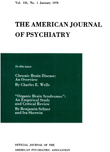CHILDHOOD PATTERNS PREDICTIVE OF ADULT SCHIZOPHRENIA: A 30-YEAR FOLLOW-UP STUDY
Abstract
A 30-year follow-up study of 526 children seen in a child guidance clinic shows that of the 284 so far interviewed, 10% were diagnosed in adult life as schizophrenic and 20% were diagnosed as no disease. The childhood histories and adult adjustment of the schizophrenic and no disease groups are compared. This comparison shows the following:
1. In childhood the schizophrenic group have more symptoms of all kinds than the no disease group including a large number of anti-social symptoms.
2. More areas of function were disturbed in the pre-schizophrenic child than in the child who in adult life had no psychiatric disease.
3. As adults the schizophrenics have a higher rate of mental hospitalizations than the no disease group.
4. The schizophrenic adults have a higher arrest rate than the no disease group. The schizophrenics are consequently often treated as criminals rather than mentally ill persons.
Access content
To read the fulltext, please use one of the options below to sign in or purchase access.- Personal login
- Institutional Login
- Sign in via OpenAthens
- Register for access
-
Please login/register if you wish to pair your device and check access availability.
Not a subscriber?
PsychiatryOnline subscription options offer access to the DSM-5 library, books, journals, CME, and patient resources. This all-in-one virtual library provides psychiatrists and mental health professionals with key resources for diagnosis, treatment, research, and professional development.
Need more help? PsychiatryOnline Customer Service may be reached by emailing [email protected] or by calling 800-368-5777 (in the U.S.) or 703-907-7322 (outside the U.S.).



